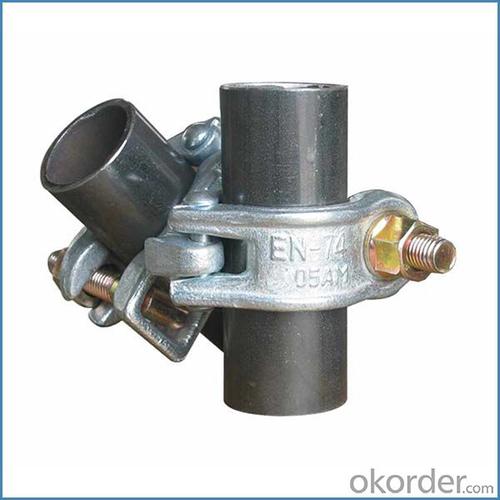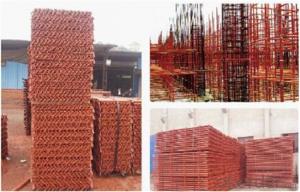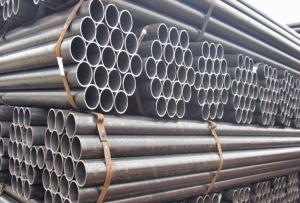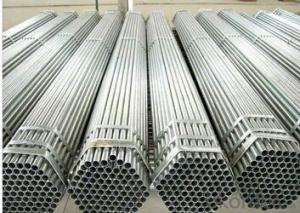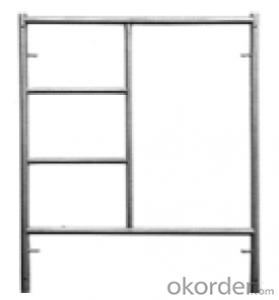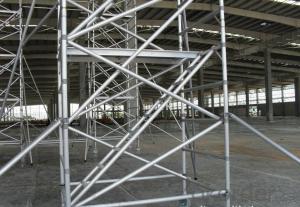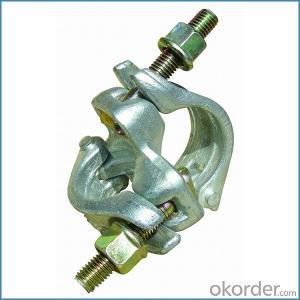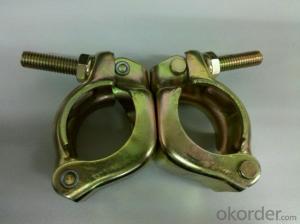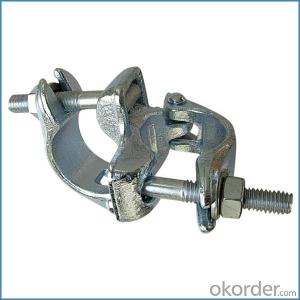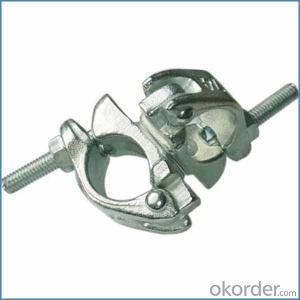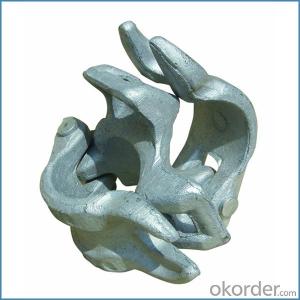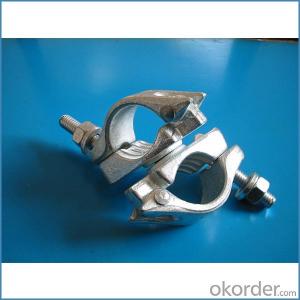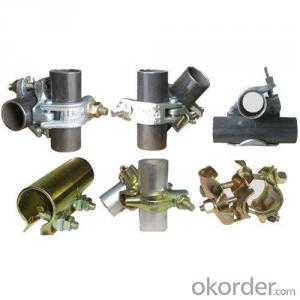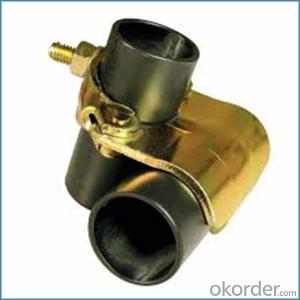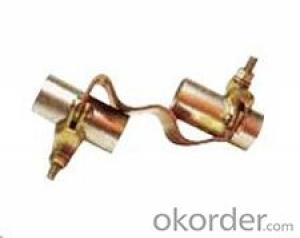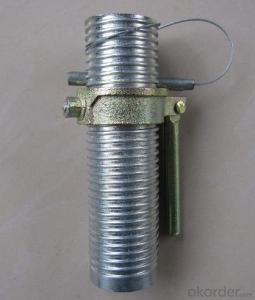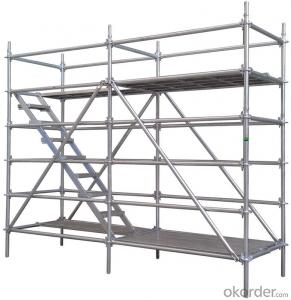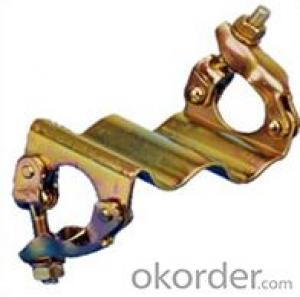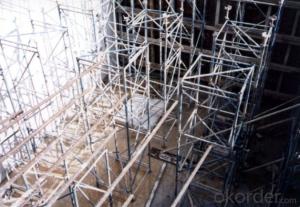Scaffolding Rapid Clamp british German Forged Type
- Loading Port:
- Tianjin
- Payment Terms:
- TT OR LC
- Min Order Qty:
- 1000 kg
- Supply Capability:
- 100000 kg/month
OKorder Service Pledge
OKorder Financial Service
You Might Also Like
Scaffolding Rapid Clamp british German Forged Type
Description
1.The scaffolding coupler is always used to connect the steel pipe as scaffolding system.
2.The often used coupler is swivel coupler and righ angle coupler .
3.We can provide types of scaffolding coupler according to your requirement.
4.Couoler can fix the 48.3mm scaffolding steel pipe tightly and make the whole scaffolding system more steadily.
Feature
(1)Excellent Anti-Breaking—Cold Pressed Steel
(2)Outstanding Resistance Deformation
(3)Strong Anti-Dropping Ability
Photo
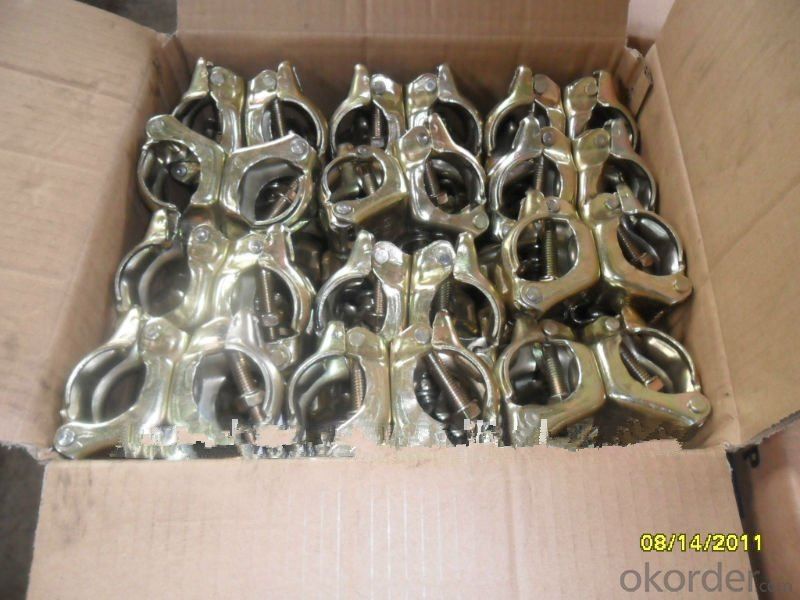
Parameter
| Material | Q235,345steel |
| Size | 48.3mm*48.3mm |
| Surface finish | Galvanized |
| Weight | 1.1kg around |
| Standard | BS1139,EN74 |
| Package | 25pcs/bag,steel pallet |
| Manufacture | As per customer requirement |
| Market | Africa, South America, the Middle East and Asia |
FAQ
Q: Are you a factory or trading company?
We are a state-owned corporation in China,dealing with various kinds of building materials.We have our holding subsidiaries.
Q: Where is your factory located? How can I visit there?
Our factory is located all around China.
Q: Can I get some samples?
Sample is free, customer only pay freight for the first time.
Q: Delivery?
10-30days. (5-15 containers)
Any question,feel free to contact us.
- Q: Are steel tube couplers suitable for scaffolding projects requiring frequent modification or extension?
- Yes, steel tube couplers are suitable for scaffolding projects requiring frequent modification or extension. Steel tube couplers are designed to provide a strong and secure connection between scaffolding tubes, making them easy to assemble and disassemble as needed. These couplers are reliable and durable, ensuring the stability and safety of the scaffolding structure. Additionally, steel tube couplers allow for flexible adjustments and extensions, making them ideal for projects that require frequent modifications or additions. Overall, steel tube couplers are a suitable choice for scaffolding projects that require adaptability and ease of modification.
- Q: Can steel tube couplers be used in combination with other scaffolding connection methods?
- Yes, steel tube couplers can be used in combination with other scaffolding connection methods. Steel tube couplers provide a strong and secure connection between scaffolding tubes, and they can be used alongside other connection methods such as bolts, clamps, or wedges to create a versatile and sturdy scaffolding structure. This allows for flexibility in designing scaffolding systems that meet specific project requirements.
- Q: Can steel tube couplers be used in scaffolding projects with extreme temperatures?
- Yes, steel tube couplers can be used in scaffolding projects with extreme temperatures. Steel is known for its durability and resistance to temperature variations, making it suitable for use in a wide range of environmental conditions, including extreme temperatures. However, it is important to ensure that the couplers are properly designed and manufactured to withstand the specific temperature requirements of the scaffolding project.
- Q: Are there any specific guidelines for the proper installation and tightening of steel tube couplers?
- There exist specific guidelines for the correct installation and tightening of steel tube couplers. To guarantee a secure and dependable connection, adherence to the following instructions is necessary: 1. Tube end cleaning and preparation: Prior to coupler installation, it is imperative to ensure that the tube ends are clean, devoid of any dirt, debris, or rust. Employ a wire brush or emery cloth to eliminate surface contaminants. 2. Measurement and marking of insertion depth: Measure and mark the desired insertion depth on the tube. This will ensure proper seating of the couplers within the tube and provide adequate support. 3. Application of lubricant: Apply a suitable lubricant to the interior of the coupler and the exterior of the tube ends. This will facilitate easier insertion and prevent galling or seizing during tightening. 4. Coupler insertion: Align the couplers with the tube ends and insert them by applying consistent and uniform pressure. Avoid excessive force or striking the couplers, as this may damage the threads or distort the coupler itself. 5. Hand tightening: Once the couplers are completely inserted, hand tighten them until snug. It is crucial not to overtighten at this stage, as it can lead to deformation or thread damage. 6. Usage of a torque wrench: Utilize a calibrated torque wrench to achieve the appropriate tightening torque. Consult the manufacturer's specifications or guidelines to determine the recommended torque value for the specific coupler size and type. 7. Cross-pattern tightening: When tightening multiple couplers, follow a cross-pattern sequence. This ensures equal distribution of tightening forces and prevents distortion or misalignment of the couplers. 8. Proper alignment inspection: After tightening, visually inspect the couplers to ensure proper alignment and seating within the tube ends. Misalignment may indicate insufficient tightening or improper installation. 9. Conduct a pull test: To confirm the connection's integrity, perform a pull test using suitable equipment. This test should adhere to industry standards or specific project requirements. 10. Documentation and record-keeping: Maintain a record of the installation process, including torque values used, inspection results, and any additional notes. This documentation can serve as a future reference or for quality control purposes. Adhering to these guidelines will help ensure a safe and secure installation of steel tube couplers, minimizing the risk of failure and providing a reliable connection for various applications. It is always recommended to consult the manufacturer's instructions and seek professional advice if uncertain.
- Q: Are there any specific considerations for using steel tube couplers in scaffolding that will be used in highly corrosive environments, such as chemical plants or offshore platforms?
- When using steel tube couplers in scaffolding for highly corrosive environments like chemical plants or offshore platforms, there are several important factors to consider. These considerations are crucial for maintaining the safety and integrity of the scaffolding structure. 1. Material Selection: It is vital to select steel tube couplers that are specifically designed and manufactured for use in highly corrosive environments. Opt for high-quality stainless steel or corrosion-resistant alloys like 316 or 316L, known for their excellent resistance to corrosion in harsh conditions. 2. Protective Coatings: Applying protective coatings to the steel tube couplers can significantly enhance their resistance to corrosion. Coatings like hot-dip galvanizing or epoxy paint provide an additional layer of protection against the corrosive elements found in chemical plants or offshore platforms. 3. Regular Inspection and Maintenance: In highly corrosive environments, regular inspections of the scaffolding structure and steel tube couplers are essential. Address any signs of corrosion or damage immediately to prevent further deterioration and potential failure. Regular maintenance, including cleaning and reapplication of protective coatings, should also be conducted to ensure the long-term durability of the couplers. 4. Compatibility with Other Materials: Consider the compatibility of the steel tube couplers with other materials used in the scaffolding system. When different types of metals or alloys, such as aluminum or carbon steel, are used in the scaffolding, precautions should be taken to prevent galvanic corrosion, which can occur when dissimilar metals are in contact in the presence of an electrolyte. 5. Environmental Conditions: Highly corrosive environments often involve extreme temperatures, humidity, chemicals, and saltwater exposure. Assess the specific environmental conditions of the chemical plant or offshore platform and choose steel tube couplers suitable for those conditions. Factors like airborne pollutants, exposure to acidic or alkaline chemicals, and the level of saltwater exposure should be considered when selecting appropriate couplers. By considering these factors, scaffolding structures in highly corrosive environments can be designed and constructed to withstand the challenges posed by corrosive elements, ensuring the safety, stability, and longevity of the scaffolding system.
- Q: Can steel tube couplers be used in both horizontal and vertical connections?
- Yes, steel tube couplers can be used in both horizontal and vertical connections. Steel tube couplers are designed to join two steel tubes together and provide a strong and secure connection. The couplers are typically used in construction projects such as scaffolding, formwork, and temporary structures. In horizontal connections, steel tube couplers are commonly used to connect horizontal beams or trusses. These connections are essential for providing stability and support to the structure. The couplers ensure a rigid joint between the steel tubes, allowing them to transfer the load effectively. Similarly, steel tube couplers can be used in vertical connections, such as connecting vertical columns or supports. These connections are crucial for maintaining the integrity and strength of the structure in a vertical direction. The couplers ensure that the steel tubes are securely fastened together, preventing any movement or displacement. Steel tube couplers are versatile and can be used in various orientations and angles. They are designed to accommodate different tube sizes and diameters, allowing for flexibility in connection design. However, it is important to ensure that the appropriate coupler type and size are selected for the specific application to ensure a safe and reliable connection. Overall, steel tube couplers are suitable for both horizontal and vertical connections, making them a versatile choice for various construction projects.
- Q: Can steel tube couplers be used in overhead scaffolding applications?
- Yes, steel tube couplers can be used in overhead scaffolding applications. Steel tube couplers are commonly used in scaffolding systems to connect and secure steel tubes together to create a stable and sturdy structure. These couplers are designed to provide a strong and reliable connection, making them suitable for use in overhead scaffolding applications where safety and stability are paramount. Whether it is for supporting platforms, walkways, or other components of the scaffolding, steel tube couplers can effectively and securely join the steel tubes together to create a robust overhead scaffolding system.
- Q: What are the different load rating classifications available for steel tube couplers?
- The different load rating classifications available for steel tube couplers include Light Duty, Medium Duty, and Heavy Duty.
- Q: What are the typical applications or industries that use steel tube couplers in scaffolding?
- Steel tube couplers are commonly used in the construction industry for various applications, particularly in scaffolding systems. Scaffolding is used to provide a temporary support structure for workers and materials during construction, maintenance, or repair projects. Steel tube couplers play a crucial role in connecting and securing the different components of scaffolding systems. The typical applications or industries that use steel tube couplers in scaffolding include: 1. Construction: Steel tube couplers are extensively used in construction projects of all sizes and types. Whether it's building residential structures, commercial buildings, bridges, or industrial facilities, scaffolding is an integral part of the construction process. Steel tube couplers ensure the stability and safety of the scaffolding structure, allowing workers to carry out their tasks at various heights. 2. Maintenance and Repair: Scaffolding is commonly employed for maintenance and repair work on existing structures such as buildings, bridges, or infrastructure. Steel tube couplers enable the assembly of scaffolding units that can be easily adjusted to fit the specific requirements of each project. This versatility allows workers to access hard-to-reach areas and perform necessary repairs or maintenance tasks effectively. 3. Oil and Gas Industry: The oil and gas industry often relies on scaffolding for various tasks such as construction, maintenance, and inspection of refineries, platforms, and pipelines. Steel tube couplers are crucial in ensuring the stability and strength of scaffolding structures in these harsh environments. They are designed to withstand extreme conditions, including high temperatures, corrosion, and heavy loads. 4. Power and Energy Sector: Power plants and energy facilities require scaffolding during construction, maintenance, and repair work. Steel tube couplers are used to connect the tubes and other components of scaffolding systems, providing a strong and reliable support structure for workers. These couplers can withstand the demanding conditions found in power plants, such as high temperatures and exposure to chemicals. 5. Infrastructure Projects: Infrastructure projects, including roads, bridges, tunnels, and railways, often require scaffolding for construction and maintenance purposes. Steel tube couplers are used extensively in these projects to ensure the safety and stability of scaffolding structures, allowing workers to access different areas for construction or repair work. Overall, steel tube couplers are widely used in the construction, maintenance, and repair industries, particularly in scaffolding applications. They offer a secure and reliable connection between scaffolding components, ensuring the safety and stability of the structure. These couplers are essential in various sectors, including construction, oil and gas, power and energy, and infrastructure projects.
- Q: a 617 N window washer is standing on a scaffold supported by a vertical rope at each end. The scaffold weighs 385 N and is 4.48m long. Assume the window washer stnads 1.06m from the left end.What is the tension of the rope on the right?What is the tension of the rope on the left?Answer in units of N.
- Set up a net moment equation. To find the tension in the rope on the right use the spot where the left rope connects to the scaffold as rotation point. Then it's just force times distance for the rope and the man and the net moment will be zero. For the the left end use the right side as your rotation point. Tr (x1) + Wm(x2) = 0 Tr = Tension in right rope x1 = length of board Wm = Weight of man x2 = man's distance from left rope.
Send your message to us
Scaffolding Rapid Clamp british German Forged Type
- Loading Port:
- Tianjin
- Payment Terms:
- TT OR LC
- Min Order Qty:
- 1000 kg
- Supply Capability:
- 100000 kg/month
OKorder Service Pledge
OKorder Financial Service
Similar products
Hot products
Hot Searches
Related keywords



